Part 49: Appendix B1 - Buildings - 1 of 3
Appendix B1 - Buildings Part 1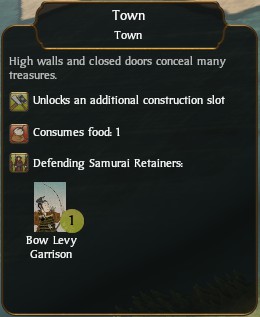
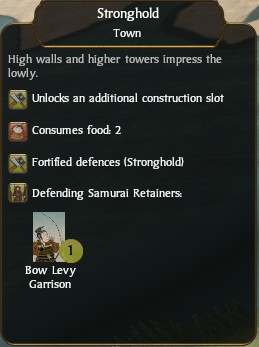
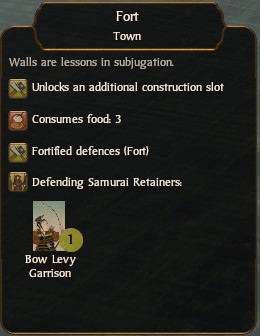
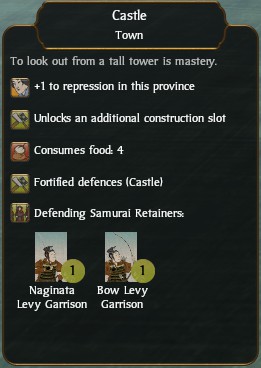
Cost: Free/1600/3200/5500
The town building chain increases the number of buildings allowed in a province as well as the size/number of walls. The first tier, Town, has only a small barricade and unlike all other tiers, troops engaged in a siege defence can rout. The provided garrison is small and of low quality. This building chain consumes food. The Stronghold chain increases the size of the city, allowing additional building chains to be constructed in the province (an additional building chain per upgrade level) and also consumes a food for each upgrade level. Additionally, the Stronghold chain increases the level of fortifications in the province. We have already seen the Town fortifications (A knee high wall), Stronghold fortifications are a wooden walled fort on a raised dirt pad. Defending troops inside this fort will fight to the death instead of retreating. Forts are an upgrade to the Stronghold and improve on it by having an outer courtyard and a further raised inner courtyard, requiring attackers to scale two sets of walls as well as allowing the defenders to fall back when one set of walls is breached. Defenders will only fight to the death in the inner courtyard, while in the outer courtyard they will still rout, although they will rout to the central keep rather than offmap, where they will reform for the final defence. Forts also add defensive archery towers, who will pelt the attacking forces with arrows while they are in range. Be careful however, as the towers can be captured by the attackers and turned against the defenders! Forts also allow the construction of another building chain in the province. The Castle adds an additional concourse to the fortifications and strengthens the existing walls, making the province almost impossible to take by force! With additional arrow towers, even a small garrison will be exceptionally difficult to dislodge. It also increases the size of the garrison force in the province as well as the repression in the province. A Castle allows the construction of an additional building chain in the province. A Castle requires access to the Wood trade good.
Ingame encyclopaedia - Town posted:
A town allows an extra specialist building to be constructed. New buildings increase the value of a province through, for example, trade, or allow a greater selection of troops to be recruited. There was a certain ambiguity in the attitude of Japanese society to the idea of towns. It was nice to have somewhere with a veneer of civilized living, but there were the people who lived in towns as well. Chonin, or townsmen, were a class that included merchants and many craftsmen not directly tied to agricultural production. While there was a certain back-breaking respectability to being a member of the peasantry, the chonin had a slightly lower status. However they earned their livings, it certainly wasn't by honest graft in the fields. Wise rulers, however, recognised that towns were vitally important to their provinces, and could be a source of considerable pride as they grew and, hopefully, flourished. It was only in a good size town that certain skilled craftsmen, goldsmiths, say, would ever find enough customers to be able to survive.
Ingame encyclopaedia - Stronghold posted:
A stronghold is a sign to the peasants of exactly who is in charge of their lives, a reminder of where loyalties should lie, and obeisance be made. It is a good base for the troops of the local garrison, enabling them to keep order in the surrounding province, and attract new recruits to their cause. Although not expected to hold out for long when besieged, a stronghold can act as a stumbling block for any invader. Japanese fortifications always had to be built to meet two conflicting priorities. Firstly, there was the obvious need to be a defensive structure that kept out enemies and was sufficiently impressive to keep the locals awed. Secondly, Japanese castles and strongholds had to survive earthquakes, a problem that most of the rest of the world did not have to consider. Japan sits on top of one of the most geologically active areas in the world, and castles could not be lumpen, monolithic structures if they were to survive a quake.
Ingame encyclopaedia - Fort posted:
This solid structure can be garrisoned to defend a province and slow down invaders, even though it will not withstand a prolonged siege. No attacking general, however, would sensibly leave troops at his rear as he advances into enemy territory. A fort therefore costs time to reduce, a precious commodity in warfare. It also reminds the local peasantry of their overlord's power, and helps that lord recruit new troops. Early Japanese fortifications were usually very practical structures, made from wood and without layered defences of walls and towers. They were intended to draw in and delay attackers rather than withstand them. Early castles were located on rivers, at ports and at other important strategic chokepoints. The builders always took full advantage of the natural landscape: mountainous positions were favoured, and nearby streams were diverted to become as moats where possible. It was common for the defenders to not lurk behind their walls when attacked: the defenders would, more often than not, sally forth to meet the enemy rather than rely on the walls. If the attackers tried to bypass the castle, the defenders would not sit idly behind their walls, but would instead raid supply lines and harass the invaders until they either retreated, or decided to take the fort.
Ingame encyclopaedia - Castle posted:
A castle is a sign of absolute ownership, stamped onto the landscape like a family seal, documenting power. It is a strong defence against enemy incursions, and a centre for administration within a province. With such an impressive structure looming over their homes, people feel secure, but they also understand that they must keep to their allotted stations in life. It also allows the province to develop further with new buildings. A castle was not only a military fixture in the life of a noble family, even though it was cunningly designed to make it as difficult to take as possible. It was also a celebration of their status and wealth. The effort of building and maintaining even one castle was almost crippling, so it became public statement of confidence, power and good taste. Beautiful craftsmanship and luxurious details made life in a castle anything but austere for the nobles. Such quiet ostentation also served to ram home the point that the owners were not to be trifled with, or ignored.
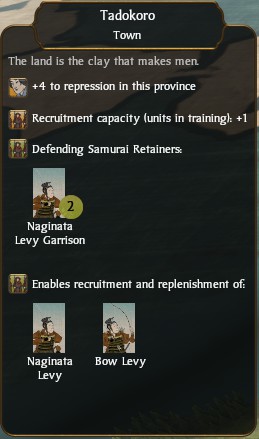
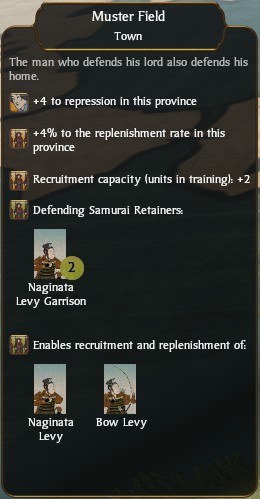
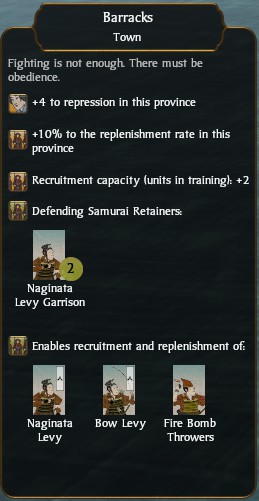
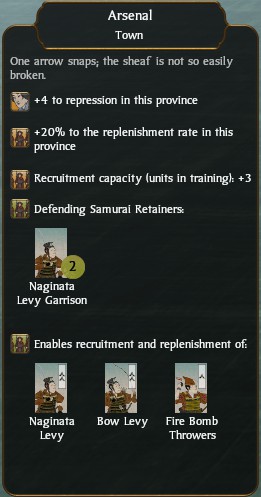
Cost: Free/1440/2880/4500
The Tadokoro is the basic garrison building for the settlement. It provides repression to the province and adds the ability to recruitment slots and the ability to recruit levy. It has two possible chains that it can be upgraded into. The first dedicated building of the Mustering chain, the Muster Field gives additional recruitment slots and replenishment rate to the province containing it. The Barracks is the third building in the Mustering chain, improving the quality of Levy produced there by 1 combat rank in addition to allowing the recruitment of Fire Bomb Throwers. It also increases the replenishment rate of the province further. The Arsenal provides an enormous boost to replenishment in the province, in addition to providing another recruitment slot, bringing the total number of units recruit-able a turn to 3. It also increases the experience of all levy units produced in the province by another 1.
Ingame encyclopaedia - Tadokoro posted:
The tadokoro has many important functions in a province. It allows the recruitment of naginata and bow-armed levies. It also allows the more efficient administration of an area, meaning that more units can be recruited at the same time, and acts as a base for law enforcement. Before the Gempei War, central authority in Japan was not strong. Individual provincial governors had every reason to keep an eye on their people, watching for signs of unrest: trouble could always be used by a jealous rival to oust a ruling family. The correct relationships between different classes in society also had to be maintained, and this is where the very public presence of an inspector, or junsatsushi, could be very useful. He alone could make sure that malcontents stayed silent.
Ingame encyclopaedia - Muster Field posted:
A muster field improves the number of men who are toughened up for military service, meaning that more units can be recruited in a province: a little discipline among civilians is no bad thing. This also helps with sending replenishment troops to understrength units. A town watch traditionally keeps the lower classes in order and watches for fires. It is also an excellent training for warriors: they learn to obey orders as well as fight. At the very least, the town watch learn such military skills as obedience, how to form ranks, stand to arms, and prepare to receive an attack. All of these are useful: if men do not act as a well-ordered unit, they will die as a disorganised mob. They may well kill many of the enemy as they die, but they will act ineffectively, not as a piece of the whole army and adding to its collective strength.
Ingame encyclopaedia - Barracks posted:
A barracks separates soldiers from the general populace, making it easier to train them and instil discipline, if only because civilians have funny ideas about deciding things for themselves. Ordinary men can be drilled and moulded into fighting warriors away from the comforts and distractions of any kind of home life. As well as recruiting new units, replacements for existing units can also be efficiently mustered and despatched to where they are needed. Every organised army in history does its best to keep its soldiers away from civilians, if only to keep desertion, drunkenness and debauchery at manageable levels! Even though life as a soldier is harsh, and never harsher than during training, it is often better than a life spent labouring in the fields. The work is hard, but then so is farming, and there is probably more chance that the new soldier, rather than the farmer, enjoys a hot meal at the end of his labours. There is danger, but then the same is true of working the land. A soldier, though, unlike the peasant, has a chance of making his fortune and changing his fate.
Ingame encyclopaedia - Arsenal posted:
An arsenal also adds greatly to the organisation and efficiency of military activities in the province. Men can be swiftly equipped and allocated to new units, or sent as replacements to understrength forces. The arsenal also houses specialist smiths, weapon workshops and stores. The various demonic mixtures needed to make firebombs can be stored here, and men trained in their safe handling, if the word "safe" can ever be applied to such hellish devices! An arsenal is often a substantial investment for any warlord, if only for the enormous quantities of armour and weapons stored there. It does, however, significantly increase military power by allowing armies to be raised quickly and easily.

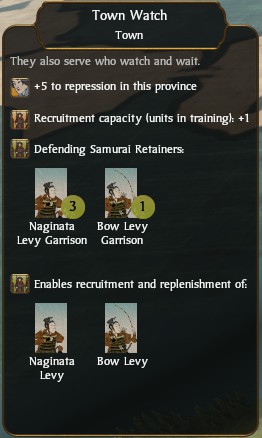
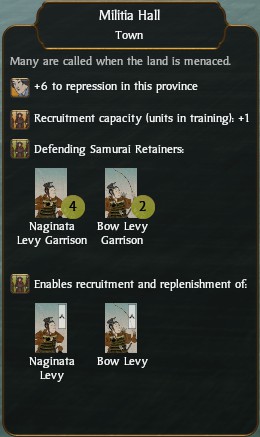
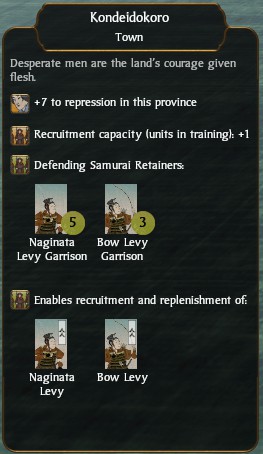
Cost: Free/1260/2520/4200
Town Watch is one of the possible upgrades to the Tadokoro and is the first building of the Watch chain. This chain increases the size of the garrison in the province as well as the amount of repression. As it is mutually exclusive with the Mustering chain, you can either have a large garrison and repression or recruitment capacity and replenishment in a province. The third building in the watch chain, Militia Hall, adds an additional Bow Levy and Naginata Levy to the garrison of the province, as well as boosting repression. It also increases the experience of levy units recruited in this province. The final building, the Kondeidokoro, boosts repression even further, adding yet another Bow Levy and Naginata Levy to the garrison, as well as adding a further rank of experience to Levy units produced here.
Ingame encyclopaedia - Tadokoro posted:
The tadokoro has many important functions in a province. It allows the recruitment of naginata and bow-armed levies. It also allows the more efficient administration of an area, meaning that more units can be recruited at the same time, and acts as a base for law enforcement. Before the Gempei War, central authority in Japan was not strong. Individual provincial governors had every reason to keep an eye on their people, watching for signs of unrest: trouble could always be used by a jealous rival to oust a ruling family. The correct relationships between different classes in society also had to be maintained, and this is where the very public presence of an inspector, or junsatsushi, could be very useful. He alone could make sure that malcontents stayed silent.
Ingame encyclopaedia - Town Watch posted:
The town watch serves to act as a central point to mobilize the people in defence of their homes, and as a potent reminder of the power of the local rulers over those same people. Local defence was a necessity, but peasants were never really expected to stand for long against samurai or other trained warriors. Peasants also could not be used for offensive actions, or sent away from their homes. At best, they could swell the numbers in an army, or the enemy would get tired out killing them before reaching the real defenders. This sounds harsh, but it was a foolish lord who allowed his entire population of strapping peasants to be slaughtered in battle. If this happened, who would gather the harvest?
Ingame encyclopaedia - Militia Hall posted:
A militia hall adds to the repression of the local people by reminding them that the military power of their overlords is all around them. It also acts as a gathering place for local defence forces, when they are needed as invaders approach. By having locals defend their own homes when his officers decide it is necessary, a warlord can also make sure that weapons only get into the hands of men who are regarded as trustworthy or, at worst, are not actively hostile to his rule. Those who are disloyal will have to face any invaders alone, and armed only with whatever implements they can find on their farms. This alone can influence the behaviour of troublemakers, because who wishes to risk his wife and children dying because they cannot be defended?
Ingame encyclopaedia - Kondeidokoro posted:
The kondeidokoro fulfils two functions. Firstly, it acts as a military post, a rallying point for the many local militia who can be called into service to defend their home province. Secondly, it is a clear sign to all that the local lord and his agents are watching, all the time, and it significantly increases repression in a province. The need for people to behave themselves was always paramount in Japan: there simply wasn't the room for troublemakers, or the opportunity to send them abroad to cause trouble for someone else. This had been the European solution: open up new lands, or invade someone. At the time of the Gempei War neither plan was an option for the Japanese, as almost every usable bit of land in Japan was already being used for something, and the nearest neighbours were China and Korea. A rigid social system was therefore a practical solution to having so many people needing to live together.
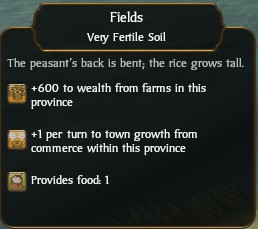
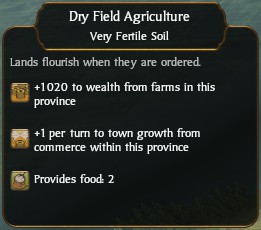
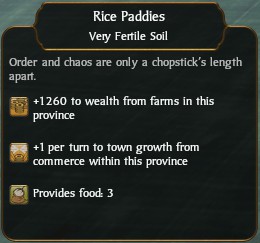
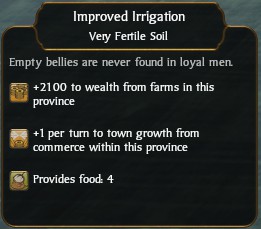
Cost: Free/950/1755/4200
Turns until profit:
code:
Province Tax Rate: 20% 25% 30% 35% 40% 45% 50% 55% 60%
Dry Field Agriculture B (950) 34 28 23 20 17 16 14 13 12
Dry Field Agriculture M (950) 27 21 18 15 14 12 11 10 9
Dry Field Agriculture A (950) 22 19 16 13 12 11 10 9 8
Dry Field Agriculture F (950) 17 14 12 10 9 8 7 7 6
Dry Field Agriculture VF (950) 12 10 8 7 6 6 5 5 4
Rice Paddies B (1755) 110 88 74 63 55 49 44 40 37
Rice Paddies M (1755) 85 68 57 49 43 38 34 31 29
Rice Paddies A (1755) 74 59 49 42 37 33 30 27 25
Rice Paddies F (1755) 55 44 37 32 28 25 22 20 19
Rice Paddies VF (1755) 37 30 25 21 19 17 15 14 13
Improved Irrigation B (4200) 75 60 50 43 38 34 30 28 25
Improved Irrigation M (4200) 58 47 39 33 29 26 24 21 20
Improved Irrigation A (4200) 50 40 34 29 25 23 20 19 17
Improved Irrigation F (4200) 38 30 25 22 19 17 15 14 13
Improved Irrigation VF (4200) 25 20 17 15 13 12 10 10 9Ingame encyclopaedia - Fields posted:
Fields physically organise the work of villages, making sure that everyone has enough good land for their crops. Agriculture is one of the oldest organised human practices. However, subsistence farming means everyone has to work hard just to have enough to eat. A field system allows a little more sophistication in the way that food is produced. Land can be left fallow, to recover its fertility, on an organised basis; or different crops can be planted each year to maintain the goodness of the soil. None of this organised activity is possible without a system of fields, and the extra food grown allows people to spend their lives on activities other than farming. It is only when there is a food surplus that potters, smiths, weavers, and a host of other craftsmen can live. A food surplus also means enough for valuable bureaucrats and important tax collectors to eat.
Ingame encyclopaedia - Dry Field Agriculture posted:
The division of a village's lands into fields means that crops can be sensibly managed over the course of the year, and land sensibly used to good purpose. Life as a peasant remains hard, because in a world without machinery all labour is backbreaking and monotonous. There is, however, the satisfaction of a slightly fuller belly in most years, and a slightly more varied diet. Dry fields crops include soybeans and other crops depending on the climate. This might only seem like a small improvement in farming methods, but the steady accumulation of such changes makes a huge difference to the lives of ordinary people, the amount of food available, and to the general economic activity of an area. The more food there is, the more time there is for skilled craftsmen to ply their trades.
Ingame encyclopaedia - Rice Paddies posted:
Paddies are artificially flooded fields where rice is grown. Rice is the staple of all Japanese people, from the lowly peasant harvesting the crop to the mightiest lord enjoying his dinner in exquisite luxury. Even taxes are measured and collected in koku, or measures, of rice. Each province's basic wealth and therefore potential tax yield is determined by its rice output. The unit of tax, the koku, was defined as the amount of rice needed to feed one man for one year. For a lord, then, a koku taken in tax directly represented one basic soldier added to his army; higher ranks would be paid the equivalent of many koku for their services. That it was possible to collect enough surplus rice to support large armies is a tribute to the efficiency of Japanese farmers over many centuries. Starvation was always a harvest away, but it was not as regular or as severe as in, say Europe, during the same period. Relatively speaking, Japanese farmers were far more productive in their work. The constant demand of rice to be paid as taxes, however, could be a terrible burden in lean years but the disloyalty of not paying tax could kill as surely as hunger.
Ingame encyclopaedia - Improved Irrigation posted:
Good farmers always try to get the most of the land that they are working. By using water cleverly, and making sure that it is not wasted, marginal land can be cultivated, effectively increasing the size and effectiveness of farms. The end result is that a province will produce more food and wealth. Japan is a very, very hilly country. It was also densely wooded, and that left little good flat land for food production. By cleverly diverting streams, and using terraced paddy fields, almost every patch of ground in Japan that could be used for growing food was eventually cultivated. The result was a very large, relatively well fed population by medieval standards. There were probably more people in Japan at the time of the Gempei War than in the whole of western Europe.

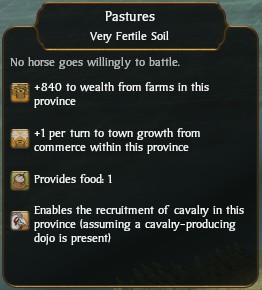
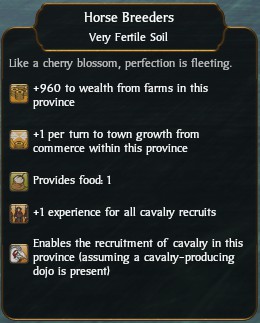
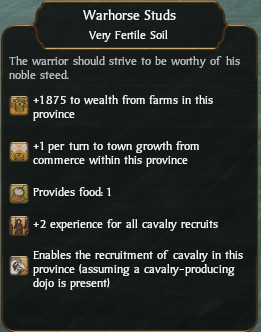
Cost: Free/980/1820/4000
Turns until profit:
code:
Province Tax Rate: 20% 25% 30% 35% 40% 45% 50% 55% 60%
Pastures B (980) 62 49 41 35 31 28 25 23 21
Pastures M (980) 48 38 32 27 24 21 19 18 16
Pastures A (980) 41 33 28 24 21 19 17 15 14
Pastures F (980) 31 25 21 18 16 14 13 12 11
Pastures VF (980) 21 17 14 12 11 10 9 8 7
Horse Breeders B (1820) 228 182 152 130 114 102 91 83 76
Horse Breeders A (1820) 175 140 117 100 88 78 70 64 59
Horse Breeders M (1820) 152 122 102 87 76 68 61 56 51
Horse Breeders F (1820) 114 91 76 65 57 51 46 42 38
Horse Breeders VF (1820) 76 61 51 44 38 34 31 28 26
Warhorse Studs B (4000) 112 89 75 64 56 50 45 41 38
Warhorse Studs A (4000) 86 69 57 49 43 38 35 32 29
Warhorse Studs M (4000) 75 60 50 43 38 33 30 27 25
Warhorse Studs F (4000) 56 45 38 32 28 25 23 21 19
Warhorse Studs VF (4000) 38 30 25 22 19 17 15 14 13Ingame encyclopaedia - Fields posted:
Fields physically organise the work of villages, making sure that everyone has enough good land for their crops. Agriculture is one of the oldest organised human practices. However, subsistence farming means everyone has to work hard just to have enough to eat. A field system allows a little more sophistication in the way that food is produced. Land can be left fallow, to recover its fertility, on an organised basis; or different crops can be planted each year to maintain the goodness of the soil. None of this organised activity is possible without a system of fields, and the extra food grown allows people to spend their lives on activities other than farming. It is only when there is a food surplus that potters, smiths, weavers, and a host of other craftsmen can live. A food surplus also means enough for valuable bureaucrats and important tax collectors to eat.
Ingame encyclopaedia - Pastures posted:
Horses are vital to samurai warfare, and strong, brave animals are preferred as mounts. Samurai are horsemen, by tradition mounted archers first and foremost. The ability to ride is as important as any skill at arms. It was only during the Sengoku Jidai period that samurai habitually fought as infantry. For much of history "samurai" was a term synonymous with "cavalry" to the Japanese. A samurai was expected to fire his bow accurately from horseback. Given that shooting needed two hands, and the samurai had to stand up in the stirrups, this required the horse and rider to be superbly trained, as the man would have to control his mount only with his knees. A good horse, then, was highly sought after and highly prized. Not only did it have to be tractable and obedient, it also had to be quite hardy to survive on campaign. It is little wonder that horses were prized possessions, just as much as good armour.
Ingame encyclopaedia - Horse Breeders posted:
Horse breeders improve the quality of cavalry trained in this province. Improving the horse stock leads to better mounts for all cavalry. Mounted combat defined the early samurai, and good horses were naturally valued for their stamina, strength and courage: a warhorse had to be tough as its rider to survive a campaign season, and not flinch from the stress of battle. They also required nearly as much training as the men. A mounted cavalryman had to control his mount, at the gallop, using only his knees so that his hands were free to use a bow. In turn, this required the horse to have spent just as much time being taught to obey absolutely and precisely. Good horses were therefore valued for their potential offspring as well as their immediate use.
Ingame encyclopaedia - Warhorse Studs posted:
For all their power and grace, horses are surprisingly delicate creatures and need a great deal of expensive care and attention. They also need a great deal of space if they are to be healthy and content. In medieval Japan this second requirement was something of a problem. A warlord who had an impressive stable of horses was not only demonstrating his military power, but he was also showing the world that money was no object to his ambitions. Stables and studs need good land and that, in Japan, has always been at a premium. The man who could afford to turn productive farmland into luxurious accommodation for his horses really was rich, important and going to impress his neighbours.
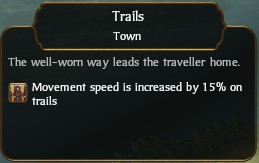
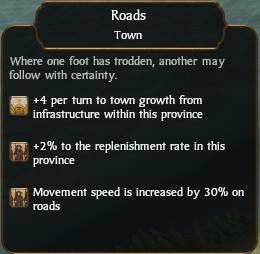

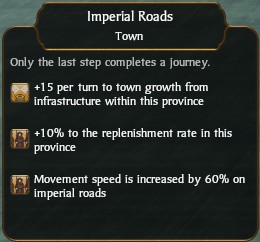
Cost: Free/2600/3950/3840
Turns until profit:
code:
Province Tax Rate: 20% 25% 30% 35% 40% 45% 50% 55% 60%
Roads (2600) 81 73 66 61 58 54 51 49 47
Post Roads and Stations (3950) 82 73 67 62 58 55 52 49 47
Imperial Roads (3840) 76 68 62 57 54 51 48 46 44Ingame encyclopaedia - Trails posted:
Trails aid movement in a province. They are little more than the tracks to and from the fields, linked by the rough paths blazed by particularly adventurous peasants.Most peasants rarely left their home village except to visit a market once or twice a year, or to go to war. Most non-warrior folk lived and died within a few miles of their birthplace. Moving on was pointless, unless there was some kind of natural disaster. Day-to-day life at the end of a road would be exactly the same as home: largely spent in a soggy field. And after all, fear of the dangers beyond the hills and forests is not conducive to casual exploration!
Ingame encyclopaedia - Roads posted:
Roads improve the movement extent of armies and agents in a province. Everything moves faster thanks to roads actually having a surface, not being a dusty track or muddy stream depending on the weather. Improved transport links also help the replenishment rate for army casualties. All comings and goings are carefully watched, of course, by officials and paid informers, meaning that line of sight is also better along roads. While roads improve the ability of people to move around this was not always what the great families wanted. It was one thing to be able to move an army swiftly, but quite another to have peasants be able to move around freely. Land without workers was, and is, entirely worthless. It generates no taxable income. If the peasants could simply leave, they might just do so! Traders, being people who did not work the land, were free to use them, because they were considered to be worth less than useful, hard working peasants.
Ingame encyclopaedia - Post Roads and Stations posted:
Post roads improve communications, allowing armies to march quickly and more replenishment troops to reach the front lines. They also allow agents to pass freely, and aid in trade. Because roads and travellers are quite closely watched and monitored, they also improve line of sight and the chance of spotting a rival's nefarious agents. Travellers can only use them if they have the proper written authorisations. Post stations were roughly a day's travel apart, and were supposed to be used by official travellers, offering rest and remounts as required. Because everyone had to report to the stations, it was relatively easy for provincial authorities to keep an eye on who was using the roads, and whether or not they could justify their journeys. Innkeepers, on the other hand, soon realised that where there were weary travellers there was a profit to be made. Historically, the close monitoring roads by central government only came about under the Tokugawa Shogunate, but from the first, only very foolish provincial lords would allow anyone to tramp across their domains.
Ingame encyclopaedia - Imperial Roads posted:
These magnificent roads and their watchtowers significantly improve the movement of armies and agents, economic growth in a province and the replenishment rate for units at the front. Guard stations monitor every traveller, so that the chances of detecting unwelcome enemy agents are greatly increased. As long as the right paperwork exists, travellers can make excellent time. A wrong or falsified internal passport, however, can mean death! The very best medieval Japanese roads were the five great routes created by Tokugawa Ieyasu, radiating out from Edo, long after the end of the Gempei War. They were entirely military in origin: to make sure he could get armies anywhere, quickly. While this was a sensible way of controlling the country, it had the added benefit of improving internal trade. The roads were so sensibly surveyed that the same routes are still in use today.
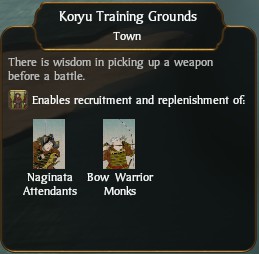
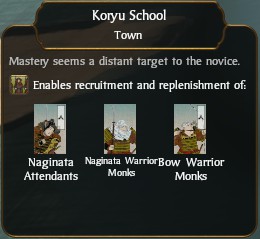
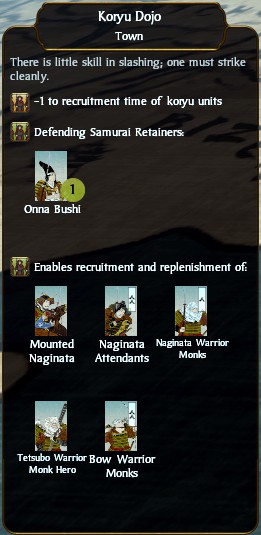
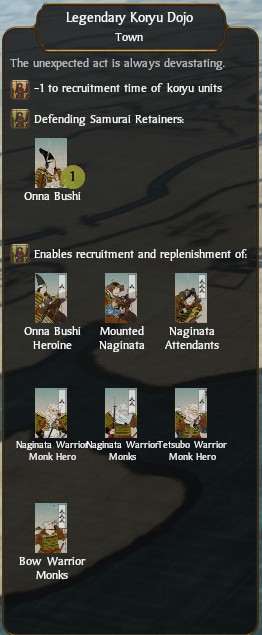
Cost: 765/1440/2800/5950
The Koryu building chain focuses on the production and replenishment of traditional defensive units which focus on the Naginata and Warrior Monks. Bow Warrior Monks also require a Buddhist Sanctuary in the same province before they can be produced. The Koryu School allows the recruitment of Naginata Warrior Monks provided an Buddhist Temple is in the same province. It also increases the experience of Bow Warrior Monk and Naginata Attendants produced there. The Koryu Dojo adds a defending garrison of Onna Bushi, reduces the recruitment time of all Koryu units by 1 turn and allows the production of Mounted Naginata and Testubo Warrior Monks with a Pastures and Buddhist Temple respectively. The Legendary Koryu Dojo allows the recruitment of Onna Bushi Heroines and Naginata Warrior Monk Heroes with a Pastures and a Famous Buddhist Temple respectively. It also increases the rank of all units produced here by a further 1 (Hero units included).
Ingame encyclopaedia - Koryu Training Grounds posted:
The training grounds have space enough to allow the training of naginata attendants. The naginata is a long weapon, and it is advisable to stand well away from any trainee swinging it with gusto! The weapon itself can be used as a spear or as a cutting blade, but it requires considerable strength as well as skill. The origins of the naginata are obscured by time. It may have developed from an agricultural implement like the English mediaeval bill developed from the farming billhook but, given its association with the samurai this seems unlikely. Samurai were gentlemen, not farmers. It is more likely that the weapon is a Japanese reinterpretation and refinement of a traditional Chinese glaive, the "yan yue dao", which translates as the rather poetic term "reclining moon blade". This does, however, quite clearly describe the shape of the business end of the weapon. The Japanese naginata's blade is slightly straighter and closer to a sword in overall form.
Ingame encyclopaedia - Koryu School posted:
The koryu school adds to the experience of any naginata units trained there. It also allows the training of naginata monks and bow monks if there is a Buddhist temple in the same province. Warrior monks or "sohei" are often depicted in Japanese art as carrying the naginata: it was a weapon of noblemen (and all monks had a certain nobility of purpose because of their calling) and one that needed skill to use. After all, any fool can swing a staff or club. The weapon seems to have come into relatively common usage for samurai and sohei during the Gempei War itself. The association with warrior monks was not always accurate, but became a convention of artistic depictions of monks in battle. Japanese artists even drew the weapon being carried by monks who had probably never even seen a naginata, let alone held one. This, however, was to emphasize the martial tradition of monks, who were far from being quiet contemplative types like their Christian contemporaries.
Ingame encyclopaedia - Koryu Dojo posted:
This koryu dojo allows the training of powerful naginata monk hero units if there is a Buddhist temple in the province. It also reduces the time needed to train other naginata units because of the excellence of teaching on offer. Naginatajutsu is, as the name suggests, the skill of fighting with a naginata. However, this is a modern style and roughly the equivalent of kendo, or Japanese fencing. It is a formalised sporting style rather than a set of practical combat techniques. Naginatajutsu still requires skill, of course, and a good deal of courage to face an equally-skilled opponent armed with a practice naginata. Koryu, on the other hand, probably translates best as "old school", and it is likely the techniques taught for battle with the naginata were different from today's kata. If nothing else, koryu would be entirely concerned with the practical business of chopping an opponent into quivering chunks, rather than trying to show proper form and impress tournament judges.
Ingame encyclopaedia - Legendary Koryu Dojo posted:
A legendary koryu dojo allows the training of onna-bushi, but this also requires a provincial headquarters in the same province. The weapon masters here also give naginata-armed units a very impressive experience bonus when they are recruited. Saito Musashibo Benkei was an almost-mythical sohei, or warrior monk, of the Gempei War period who served Minamoto no Yoshitsune with some distinction. Although his life and acts have been much embellished over the years by legend, Benkei does seem to have been an exceptionally strong man. He is also credited as a cunning fighter, and is supposed to have collected 999 swords from his defeated opponents, a number that looks suspiciously convenient when telling a good yarn! He is also credited with defending the bridge during the Battle of Koromo River, giving Minamoto no Yoshitsune enough time to commit suicide with dignity. Benkei's death was suitably heroic: the enemy were too scared to approach the huge monk, and then realised that he wasn't moving. He had died standing up, keeping the enemy at bay even in death.
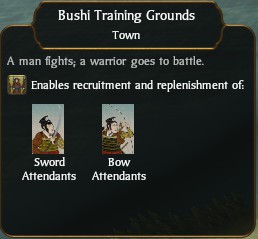
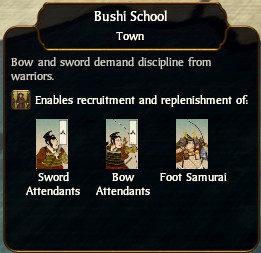

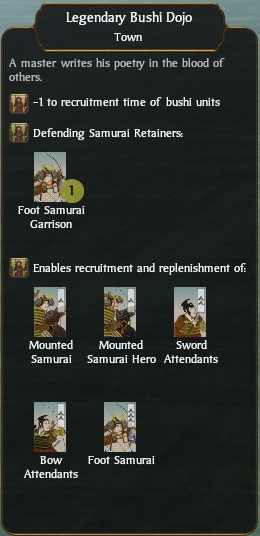
Cost: 765/1440/3200/6800
The Bushi building chain focuses on the production and replenishment of offensive units that focus on the sword and bow, such as Sword Attendants and Bow Attendants. The Bushi School allows the recruitment of Foot Samurai and rank 1 Bow/Sword Attendants. The Bushi Dojo adds a regiment of Foot Samurai garrison, reduces the recruitment time of all Bushi units by 1 turn and allows the production of Mounted Samurai with a Pastures. It also increases the experience of Bow Attendants, Sword Attendants and Foot Samurai produced there. The Legendary Bushi Dojo allows the recruitment of Mounted Samurai Heroes with a Pastures. It also increases the rank of all units produced here by a further 1 (Hero units included), with the exception of Foot Samurai, which it increases by 2. You may only have one Legendary Bushi Dojo and it requires access to the Iron trade good.
Ingame encyclopaedia - Bushi Training Grounds posted:
Bushi training grounds allow the recruitment of basic sword- and bow-armed troops.The way of the warrior, later called bushido, lay at the heart of everything that a samurai could be, or hoped to become. While a samurai was expected to be a master of sword and bow, there was a moral element to his training as well, a core set of ethics that guided his life in every waking minute. More than just a code of chivalry or a set of martial arts for using weapons with surpassing skill, bushido was a guide to living and dying with honour. It was the "dying" part that made bushido different from many other warrior systems: death had no bearing on whether a course of action could be considered failure. The only failure was not to carry through an action when it was the right thing to do as a warrior.
Ingame encyclopaedia - Bushi School posted:
This school allows the training of samurai infantry, and improves the expertise of other bushi (warriors). Long years of training are required to understand the way of the warrior, and to train mind and muscles to the point where a stroke or shot can be made without conscious thought. A warrior needs to empty his mind of everything – even, or perhaps especially, fear, hope and anger - if he is to fight to his full potential. The thousands of hours spent with sword and bow empty the man of everything except the need to perform the perfect act. In that moment of still perfection, he can defeat any opponent without considering anything other than victory. Such training is necessary, but expensive for the warlord who wants his men to be the best.
Ingame encyclopaedia - Bushi Dojo posted:
Nearly every warrior culture on the Eurasian landmass defined its warrior elite as fighters on horseback. The word for "cavalryman" is often synonymous with a ruling, higher social caste within a society. They quite literally look down on the peasants. This is not surprising: apart from anything else, the expense of buying and owning a horse meant than anyone who had a warhorse was, by definition, an important man in the community. The samurai began as mounted warriors. As a child, a samurai was put in the saddle almost as soon as he could walk. His weapons training emphasised battle from horseback, although the earliest samurai fought as mounted bowmen, using their horses to move swiftly away from any threat before returning to harass their enemies once again. Early samurai armour, for example, is perfect for this fighting style; it will keep out arrows rather effectively, but not sword cuts.
Ingame encyclopaedia - Legendary Bushi Dojo posted:
Samurai warfare was, at least initially, an affair of individuals who acted independently on the battlefield. Men would advance towards their enemies, calling out their names and achievements in the hopes of finding a worthy opponent to fight. This kind of affair is not so much a battle as a massive series of duels between brave men. A warrior tagged the head of his slain enemy, and these were displayed after the battle to determine each man's contribution to victory. It was, by the way, a very bad idea to take the head of a friend in the confusion of battle. However, the idea of individual heroism is a powerful one, and one that the way of the warrior embodied in many ways. Every warrior on the battlefield would regard a truly heroic warrior, even an enemy, with admiration.